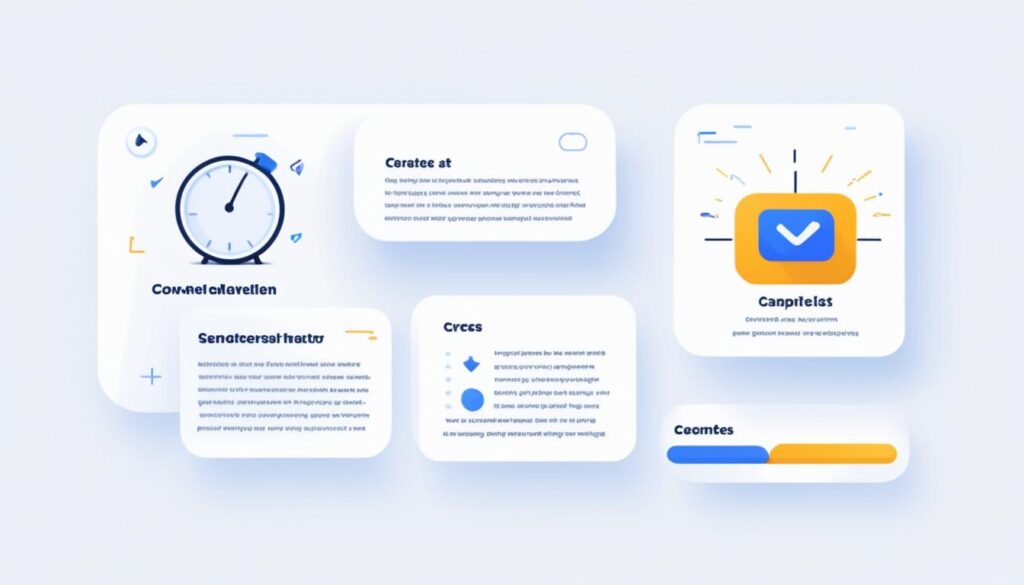Featured snippets are a game-changer when it comes to boosting your business’s online presence and SEO strategy. By securing a spot at the top of search engine result pages (SERPs), even if your website ranks lower organically, featured snippets ensure maximum visibility in competitive search results.
So, what exactly are featured snippets? They are concise summaries of text that directly answer users’ queries in the search results. Appearing as a featured box at the top of the SERPs, they provide users with quick and concise information, driving more traffic to your website.
Optimizing for featured snippets involves various strategies, such as using appropriate headings and structuring content with concise answers. It’s also important to optimize for voice search, as voice assistants often read out featured snippets as the primary result. By implementing these strategies, you can enhance your business’s credibility and authority, as Google has chosen your website as the most relevant and helpful resource for a specific query.
Key Takeaways:
- Featured snippets can boost your business’s online presence and SEO strategy.
- They provide concise summaries of text that directly answer users’ queries in the search results.
- Optimizing for featured snippets involves using appropriate headings and structuring content with concise answers.
- Optimizing for voice search is essential, as voice assistants often read out featured snippets as the primary result.
- Securing a featured snippet enhances your business’s credibility and authority in the eyes of users and search engines.
What are Featured Snippets?
Featured snippets are brief summaries of text that directly answer a user’s query in the search results. They appear as a featured box at the top of the SERPs, providing users with quick and concise information.
There are three main types of featured snippets: paragraph snippets, list snippets, and table snippets. Paragraph snippets consist of a few sentences pulled from a web page’s <p> HTML element. List snippets are bulleted or numbered lists extracted from <ol> or <ul> HTML elements. Table snippets present information from a <table> HTML element.
Understanding these snippet types is crucial for optimizing content to appear as a featured snippet.

Featured Snippet Types
The different types of featured snippets provide unique ways to present information to users, depending on the nature of their query. Here’s an overview of the main featured snippet types:
- Paragraph Snippets: These snippets are ideal for providing concise explanations or descriptions of a topic. They are commonly used to answer “how-to” questions, define terms, or give brief overviews.
- List Snippets: List snippets offer information in a clear and structured format, making them suitable for step-by-step instructions, top-rated products, or any content that can be presented as a list.
- Table Snippets: Table snippets are perfect for displaying organized and tabular data. They work well for comparisons, specifications, pricing, or any content that can be efficiently presented in a table format.
By optimizing content to align with these featured snippet types, businesses can increase their chances of appearing as a prominent and helpful result in the search results.
The Benefits of Optimizing for Featured Snippets
Optimizing for featured snippets provides numerous benefits for businesses. By appearing in the featured snippet position, a website can boost its visibility, increase click-through rates (CTR), and drive more traffic.
When a website occupies the top spot in the SERPs as a featured snippet, it gains credibility and authority. This is because Google has chosen it as the most relevant and helpful result for a specific query. Such recognition can enhance a business’s reputation, establish trust, and attract more organic traffic.
But the benefits of optimizing for featured snippets go beyond visibility and traffic. These prominent positions also offer an opportunity to showcase rich content, such as videos or reviews. By incorporating multimedia elements, businesses can engage users, enhance brand awareness, and create a memorable online experience.
“Optimizing for featured snippets can significantly boost a website’s visibility and credibility, driving more traffic and attracting potential customers.” – SEO Expert
Furthermore, being featured in snippets can have a domino effect on other search engine rankings. When Google showcases a website as the featured result, it signals to users that this site has the most relevant information. Consequently, users are more likely to click on the website’s link, increasing its CTR and potentially improving its organic search rankings for related keywords.
To sum up, optimizing for featured snippets offers a range of benefits for businesses, including boosting visibility, increasing CTR, driving traffic, and enhancing credibility. By creating content that is authoritative, informative, and concise, businesses can increase their chances of appearing as the featured snippet, capitalizing on these advantages and solidifying their online presence.
Strategies for Optimizing Content for Featured Snippets
To maximize the chances of your content being selected as a featured snippet, implementing effective optimization strategies is crucial. Here are some proven tactics to optimize your content:
Create FAQ Content
One effective approach is to create content in a frequently asked questions (FAQ) format. Address specific questions that your target audience is searching for, and provide clear and concise answers. By structuring your content around common queries, you increase the likelihood of it being featured as a snippet.
Implement Q&A Formatting
Utilize Q&A formatting to structure your content effectively. This allows for easy navigation and enhances the readability of your answers. Use headings, subheadings, and bullet points to organize your content and make it more accessible to both users and search engines.
Include Relevant Keywords in Headers
Optimize your headers by including relevant keywords. This helps search engines understand the context of your content and increases the chances of it being selected as a featured snippet. Make sure your headers accurately reflect the content that follows and provide concise summaries of the information being presented.
Offer Concise and Accurate Answers
Featured snippets prioritize content that provides clear and concise answers to user queries. Make sure your answers are direct, informative, and address the specific query being posed. Avoid unnecessary fluff or excess information, as it may decrease the chances of your content being selected as a snippet.
Provide High-Quality Content
The quality of your content is paramount in optimizing for featured snippets. Ensure your content is well-researched, accurate, and authoritative. Use credible sources and provide valuable insights to demonstrate your expertise on the topic. High-quality content is more likely to be selected as a featured snippet.
Format Your Content Appropriately
Formatting your content based on the type of featured snippet can significantly improve its chances of being selected. Use subheadings, lists, or tables, depending on the nature of your content. This makes it easier for search engines to understand and present your information in a snippet format.

By implementing these strategies, you can optimize your content for featured snippets and increase its visibility on search engine result pages. Remember to focus on FAQ content, utilize Q&A formatting, incorporate relevant keywords in headers, provide concise answers, deliver high-quality content, and format your content appropriately based on the type of snippet you want to achieve.
The Role of Structured Data in Optimizing for Featured Snippets
Structured data plays a crucial role in optimizing content for featured snippets. By implementing schema markup, businesses can improve search engines’ understanding of their website content, thereby increasing the chances of gaining rich results on the SERPs. Structured data enables websites to provide additional context and metadata, allowing search engines to present more informative search results to users.
One of the key benefits of structured data is its ability to enhance sitelinks. Sitelinks are additional links that appear below a website’s main result in the SERPs, leading users to different sections or pages within the site. By implementing structured data, businesses can increase the visibility of their sitelinks, making it easier for users to navigate their website. This not only improves the user experience but also drives more targeted traffic to specific pages.
Moreover, structured data is instrumental in obtaining rich snippets. Rich snippets are enhanced search results that include additional information beyond the traditional blue link and meta description. For specific types of content, such as recipes or reviews, implementing structured data using Schema.org vocabulary ensures that the search engine presents the content in a more visually appealing and interactive format.
Proper content formatting is crucial when implementing structured data for featured snippets. Websites should ensure that their content is well-structured, organized, and adheres to schema guidelines. Furthermore, leveraging JSON-LD (JavaScript Object Notation for Linked Data) is an effective way to incorporate structured data into a website’s HTML without disrupting the user experience. JSON-LD allows businesses to embed structured data directly into their HTML, making it easier for search engines to interpret the content and present it as a featured snippet on the SERPs.
Structured data is a powerful tool that businesses should leverage to optimize their content for featured snippets. By implementing schema markup, enhancing sitelinks, and obtaining rich snippets, businesses can improve their visibility, drive more targeted traffic, and ultimately enhance their overall SEO strategy.
| Structured Data Benefits | Schema Markup | Sitelinks | Rich Snippets |
|---|---|---|---|
| Enhanced understanding of website content | Improved navigation and user experience | Visually appealing and interactive search results | |
| Increased chances of appearing as a featured snippet | Targeted traffic to specific website pages | Additional context and metadata | |
| Improved search engine visibility |
Conclusion
Optimizing content for featured snippets is a vital strategy for businesses looking to boost their search visibility and improve their overall SEO strategy. By appearing in a featured snippet position, websites can effectively stand out in the SERPs and drive more traffic to their pages.
Following best practices such as creating FAQ-style content, structuring information effectively, providing concise answers, and implementing structured data can significantly increase the chances of being selected as a featured snippet. These practices not only help businesses capture the attention of users but also enhance their credibility and authority in their respective industries.
Continuously monitoring and updating featured snippets is essential to ensure optimal performance and contribute to the long-term success of a business’s online presence. By staying proactive and adapting to the evolving search landscape, businesses can stay ahead of their competitors and reap the benefits of optimized featured snippets.
FAQ
What are featured snippets?
Featured snippets are brief summaries of text that directly answer a user’s query in the search results. They appear as a featured box at the top of the SERPs, providing users with quick and concise information.
What types of featured snippets are there?
There are three main types of featured snippets: paragraph snippets, list snippets, and table snippets. Paragraph snippets consist of a few sentences pulled from a web page’s <p> HTML element. List snippets are bulleted or numbered lists extracted from <ol> or <ul> HTML elements. Table snippets present information from a <table> HTML element.
What benefits do featured snippets provide?
Optimizing for featured snippets provides numerous benefits for businesses. Appearing in the featured snippet position not only boosts a website’s visibility but also increases its click-through rate (CTR) and drives more traffic. Featured snippets also offer an opportunity to showcase rich content, such as videos or reviews, further enhancing brand awareness and engagement.
How can I optimize content for featured snippets?
To optimize content for featured snippets, businesses can employ various strategies. One effective approach is creating FAQ-style content that addresses specific questions their target audience is searching for. Q&A formatting can help structure the content effectively, allowing for clear answers to queries. Including relevant keywords in headers, offering concise and accurate answers, and providing high-quality content are all essential aspects of optimization. Formatting content based on the type of featured snippet, such as using subheadings, lists, or tables, can improve its chances of being selected as a featured snippet.
What is the role of structured data in optimizing for featured snippets?
Structured data plays a crucial role in optimizing content for featured snippets. Implementing schema markup helps search engines understand website content better, increasing the chances of gaining rich results on the SERPs. Structured data can also enhance sitelinks, which provide additional links to different areas of a website, increasing its visibility and improving user experience. Employing proper content formatting and using JSON-LD can help ensure the successful implementation of structured data for featured snippets.








